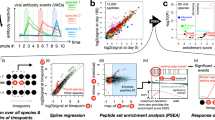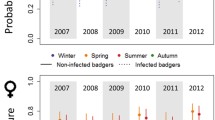Abstract
We present a new analysis of relationships between disease incidence and the prevalence of an experimentally defined state of ‘recent infection’. This leads to a clean separation between biological parameters (properties of disease progression as reflected in a test for recent infection), which need to be calibrated, and epidemiological state variables, which are estimated in a cross-sectional survey. The framework takes into account the possibility that details of the assay and host/pathogen chemistry leave a (knowable) fraction of the population in the recent category for all times. This systematically addresses an issue which is the source of some controversy about the appropriate use of the BED assay for defining recent HIV infection. The analysis is, however, applicable to any assay that forms the basis of a test for recent infection. Analysis of relative contributions of error arising variously from statistical considerations and simplifications of general expressions indicate that statistical error dominates heavily over methodological bias for realistic epidemiological and biological scenarios.
Similar content being viewed by others
References
Agresti A (2002) Categorical data analysis, 2nd edn. Wiley, New York
Brookmeyer R, Quinn TC (1995) Estimation of current human immunodeficiency virus incidence rates from a cross-sectional survey using early diagnostic tests. Am J Epidemiol 141(2): 166–172
Cole SR, Chu H, Brookmeyer R (2006) Confidence intervals for biomarker-based human immunodeficiency virus incidence estimates and differences using prevalent data. Am J Epidemiol 165(1): 94–100
Hargrove JW, Humphrey JH, Mutasa K, Parekh BS, McDougal JS, Ntozini R, Chidawanyika H, Moulton LH, Ward B, Nathoo K, Iliff PJ, Kopp E (2008) Improved HIV-1 incidence estimates using the BED capture enzyme immunoassay. AIDS 22(4): 511–518
Janssen RS, Satten GA, Stramer SL, Rawal BD, O’Brien TR, Weiblen BJ, Hecht FM, Jack N, Cleghorn FR, Kahn JO, Chesney MA, Busch MP (1998) New testing strategy to detect early HIV-1 infection for use in incidence estimates and for clinical and prevention purposes. JAMA 280(1): 42–48
McDougal JS, Parekh BS, Peterson ML, Branson BM, Dobbs T, Ackers M, Gurwith M (2006) Comparison of HIV type 1 incidence observed during longitudinal follow-up with incidence estimated by cross-sectional analysis using the BED capture enzyme immunoassay. AIDS Res Hum Retroviruses 22(10): 945–952
McWalter TA, Welte A (2008) On the estimation of the proportion of true recent infections using the BED capture enzyme immunoassay. Available at http://arxiv.org/abs/0806.1297
Parekh BS, Kennedy SM, Dobbs T, Pau C-P, Byers R, Green T, Hu DJ, Vanichseni S, Young NL, Choopanya K, Mastro TD, McDougal JS (2002) Quantitative detection of increasing HIV type 1 antibodies after seroconversion: A simple assay for detecting recent HIV infection and estimating incidence. AIDS Res Hum Retroviruses 18(4): 295–307
Parekh BS, McDougal JS (2001) New approaches for detecting recent HIV-1 infection. AIDS Rev 3: 183–193
Posner SJ, Myers L, Hassig SE, Rice JC, Kissinger P, Farley TA (2004) Estimating HIV incidence and detection rates from surveillance data. Epidemiology 15(2): 164–172
Welte A, McWalter TA, Bärnighausen T (2009) A simplified formula for inferring HIV incidence from cross-sectional surveys using a test for recent infection. AIDS Res Hum Retroviruses 25(1): 125–126
Wong K-F, Tsai W-Y, Kuhn L (2006) Estimating HIV hazard rates from cross-sectional HIV prevalence data. Stat Med 25(15): 2441–2449
Author information
Authors and Affiliations
Corresponding author
Rights and permissions
About this article
Cite this article
McWalter, T.A., Welte, A. Relating recent infection prevalence to incidence with a sub-population of assay non-progressors. J. Math. Biol. 60, 687–710 (2010). https://doi.org/10.1007/s00285-009-0282-7
Received:
Revised:
Published:
Issue Date:
DOI: https://doi.org/10.1007/s00285-009-0282-7




